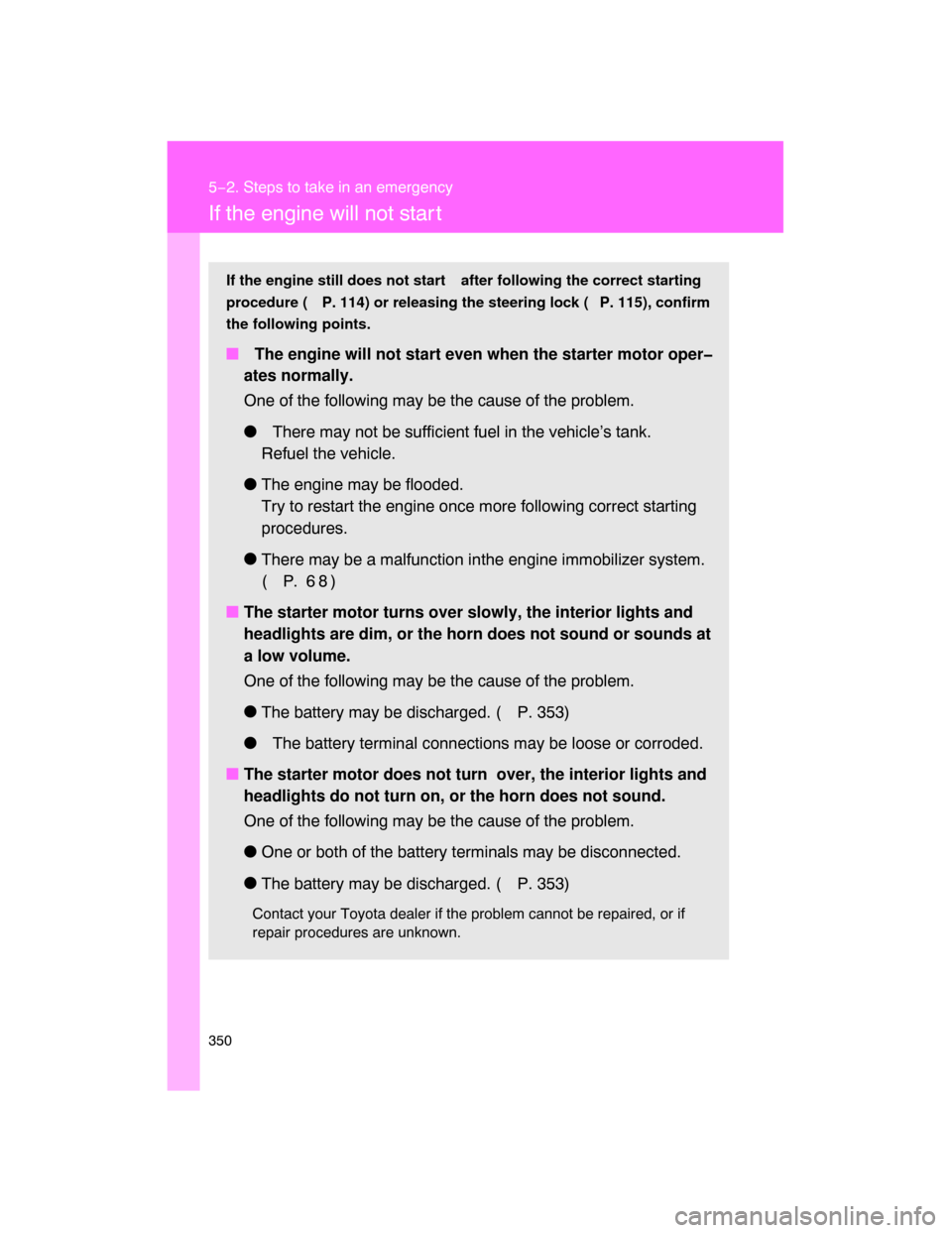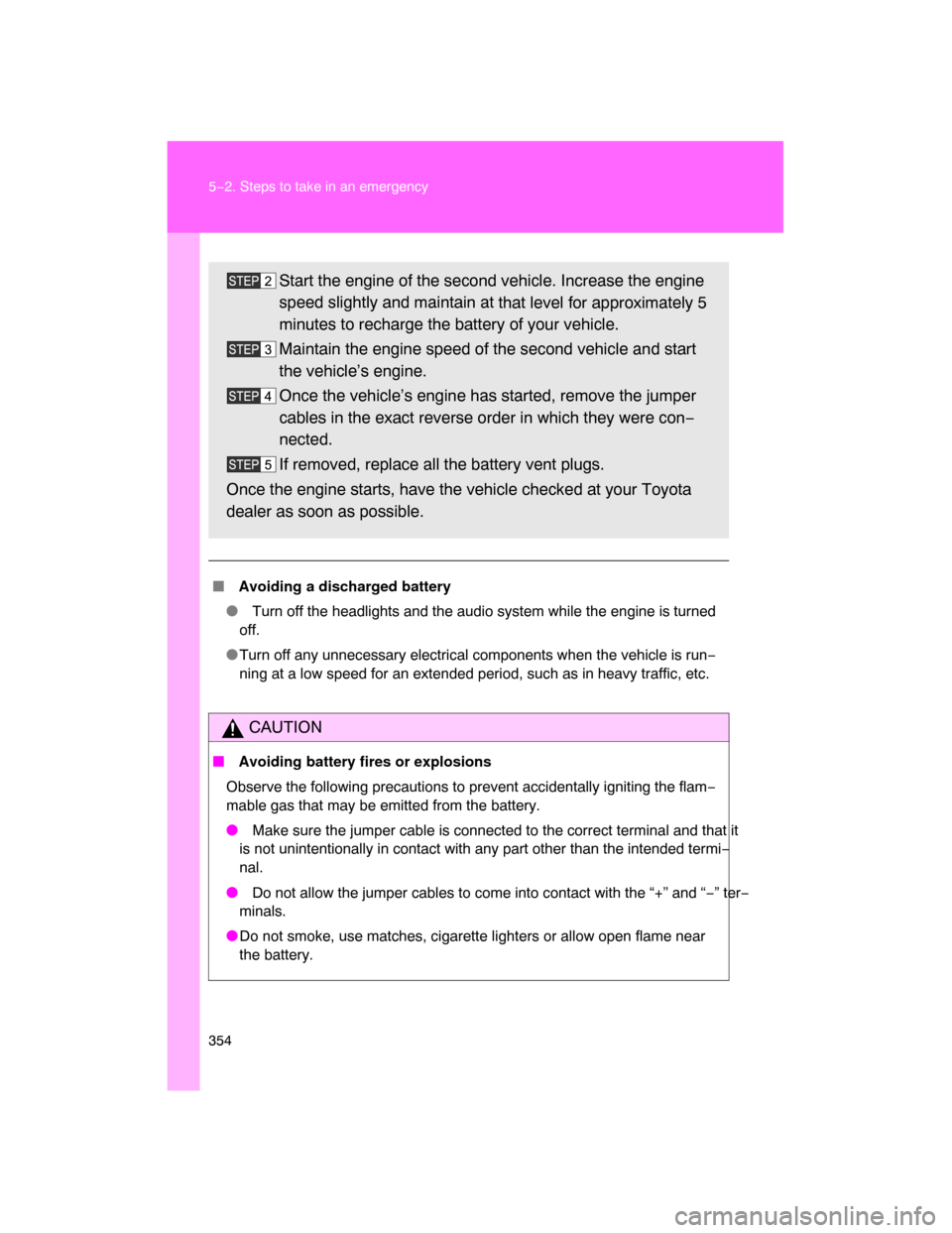Page 332 of 400

5
When trouble arises
337 5−2. Steps to take in an emergency
�If the tire pressure warning system is inoperative
The tire pressure warning system may become inoperative in the follow−
ing conditions:
(When the condition be
comes normal, the system will work properly.)
�If tires not equipped with tire pressure warning valves and transmit−
ters are used.
�If the ID code on the tire pressure warning valves and transmitters is
not registered in the tire pressure warning computer.
�If electronic devices or facilities us ing similar radio wave frequencies
are nearby.
�If a radio set at similar frequencies is in use in the vehicle.
�If a window tint that affects the radio wave signals is installed.
�If there is a lot of snow or ice on the vehicle, in particular around the
wheels or wheel housings.
�If non−genuine Toyota wheels are used.
�If tire chains are used.
�If the spare tire is in a location subject to poor radio wave signal
reception.
�If the tire inflation pressure is more than 73 psi (500 kPa, 5.1 kgf/cm2
or bar) or higher.
�If the tire pressure warning light comes on after blinking for 1
minute frequently
If the tire pressure warning light comes on after blinking for 1 minute fre−
quently when the engine switch is
turned to the ON position, have it
checked by your Toyota dealer.
� After changing the engine oil (U.S.A. only)
Make sure to reset the oil maintenance data. ( P. 278)
� Customization that can be configured at Toyota dealer
The vehicle speed linked seat belt reminder buzzer can be disabled.
(Customizable features
P. 386)
Page 333 of 400

338 5−2. Steps to take in an emergency
CAUTION
�Maintenance of the tire
Each tire, including the spare (if provided), should be checked monthly
when cold and inflated to the inflation pressure recommended by the
vehicle manufacturer on the vehicle
placard or tire inflation pressure
label (tire and load information label). (If your vehicle has tires of a differ−
ent size than the size indicated on the vehicle placard or tire inflation
pressure label [tire and load information label], you should determine the
proper tire inflation pr
essure for those tires.)
As an added safety feature, your
vehicle has been equipped with a tire
pressure monitoring system (TPMS−ti re pressure warning system) that
illuminates a low tire pressure telltal e (tire pressure warning light) when
one or more of your tires is significantly under−inflated. Accordingly,
when the low tire pressu
re telltale (tire pressure warning light) illumi−
nates, you should stop and check your tires as soon as possible, and
inflate them to the proper pressure. Driving on a significantly under−
inflated tire causes the tire to overheat and can lead to tire failure.
Under−inflation also reduces fuel effi
ciency and tire tread life, and may
affect the vehicle’s handling and stopping ability.
Please note that the TPMS (tire pressure warning system) is not a sub−
stitute for proper tire main tenance, and it is the driver ’s responsibility to
maintain correct tire pressure, even if under−inflation has not reached the
level to trigger illu
mination of the TPMS low ti re pressure telltale (tire
pressure warning light).
Your vehicle has also been equipped with a TPMS (tire pressure warning
system) malfunction indicator to indi cate when the system is not operat−
ing properly. The TPMS (tire pressure warning system) malfunction indi−
cator is combined with the low tire pressure telltale (tire pressure
warning light). When the system det
ects a malfunction, the telltale will
flash for approximately one minute an d then remain continuously illumi−
nated. This sequence will
continue upon subsequent vehicle start−ups as
long as the malfunction exists. When the malfunction indi cator is illumi−
nated, the system may not be able to detect or signal low tire pressure
as intended.
Page 334 of 400

5
When trouble arises
339 5−2. Steps to take in an emergency
CAUTION
TPMS (tire pressure warning system ) malfunction may occur for a vari−
ety of reasons, including the installati
on of replacement or alternate tires
or wheels on the vehicle that prevent the TPMS (tire pressure warning
system) from functioning properly. Always check the TPMS (tire pres−
sure warning system) malfunction te
lltale after replacing one or more
tires or wheels on your vehicle to ensure that the replacement or alter−
nate tires and wheels allow the TPMS (tire pressure warning system) to
continue to function properly.
�If the tire pressure warning light comes on
Be sure to observe the following precautions. Failure to do so could
cause loss of vehicle control and result in death or serious injury.
�Stop your vehicle in a safe place as
soon as possible. Adjust the tire
inflation pressure immediately.
�If the tire pressure warning light comes on even after tire inflation pres−
sure adjustment, it is probable that you have a flat tire. Check the tires.
If the tire is flat, change to the spare tire and have the flat tire repaired
by the nearest Toyota dealer.
�Avoid abrupt maneuvering and braking. If the vehicle tires deteriorate,
you could lose control of the steering wheel or the brakes.
�If a blowout or sudden air leakage should occur
The tire pressure warning system may not activate immediately.
NOTICE
�Precaution when installing a different tire
When a tire of a different specification or maker is installed, the tire pres−
sure warning system may
not operate properly.
Page 338 of 400
5
When trouble arises
343 5−2. Steps to take in an emergency
Aluminum wheel
Remove the wheel ornament
using the wheel nut wrench as
shown.
To protect the wheel and wheel
ornament, place a rag between
the wrench and the wheel orna−
ment, as shown in the illustra−
tion.
Steel wheel
Remove the wheel ornament
using the wheel nut wrench as
shown.
To protect the wheel and wheel
ornament, place a rag between
the wrench and the wheel orna−
ment, as shown in the illustra−
tion.
Slightly loosen the wheel nuts
(one turn).
Page 339 of 400
344 5−2. Steps to take in an emergency
Position the jack at the correct
jack point as shown.
Front
Rear
Make sure the jack is positioned
on a level and solid place.
Assemble the jack handle exten−
sion as shown. Be sure to tighten
each bolt securely.
Raise the vehicle until the tire is
slightly raised off the ground.
When positioning the jack under
the rear axle housing, make
sure the groove on the top of
the jack fits with the rear axle
housing.
Remove all the wheel nuts and
the tire.
When resting the tire on the
ground, place the tire so that the
wheel design faces up to avoid
scratching the wheel surface.
Front
Page 345 of 400

350
5−2. Steps to take in an emergency
If the engine will not star t
If the engine still does not start after following the correct starting
procedure ( P. 114) or releasing the steering lock ( P. 115), confirm
the following points.
� The engine will not start even when the starter motor oper�
ates normally.
One of the following may be the cause of the problem.
� There may not be sufficient fuel in the vehicle’s tank.
Refuel the vehicle.
�The engine may be flooded.
Try to restart the engine once more following correct starting
procedures.
�
There may be a malfunction inthe engine immobilizer system.
(P. 6 8 )
�
The starter motor turns over slowly, the interior lights and
headlights are dim, or the horn does not sound or sounds at
a low volume.
One of the following may be the cause of the problem.
�
The battery may be discharged. ( P. 353)
� The battery terminal connections may be loose or corroded.
�The starter motor does not turn over, the interior lights and
headlights do not turn on, or the horn does not sound.
One of the following may be the cause of the problem.
�
One or both of the battery terminals may be disconnected.
�
The battery may be discharged. ( P. 353)
Contact your Toyota dealer if the problem cannot be repaired, or if
repair procedures are unknown.
Page 349 of 400

354 5−2. Steps to take in an emergency
� Avoiding a discharged battery
� Turn off the headlights and the audio system while the engine is turned
off.
�
Turn off any unnecessary electrical components when the vehicle is run−
ning at a low speed for an extended period, such as in heavy traffic, etc.
CAUTION
� Avoiding battery fires or explosions
Observe the following precautions to prevent accidentally igniting the flam−
mable gas that may be emitted from the battery.
� Make sure the jumper cable is connected to the correct terminal and that it
is not unintentionally in contact with any part other than the intended termi−
nal.
� Do not allow the jumper cables to come into contact with the “+” and “−” ter−
minals.
�
Do not smoke, use matches, cigarette lighters or allow open flame near
the battery.
Start the engine of the second vehicle. Increase the engine
speed slightly and maintain at
that level for approximately 5
minutes to recharge the battery of your vehicle.
Maintain the engine speed of the second vehicle and start
the vehicle’s engine.
Once the vehicle’s engine has started, remove the jumper
cables in the exact reverse order in which they were con−
nected.
If removed, replace all the battery vent plugs.
Once the engine starts, have the vehicle checked at your Toyota
dealer as soon as possible.
Page 360 of 400
366 6−1. Specifications
Cooling system
Ignition system
Electrical system
Capacity
Vehicles with an automatic transmission
10.4 qt. (9.8 L, 8.6 Imp.qt.)
Vehicles with a manual transmission
9.9 qt. (9.4 L, 8.3 Imp. qt.)
Coolant typeUse either of the following.
�“Toyota Super Long Life Coolant”
�Similar high−quality ethylene glycol−based
non−silicate, non−amine, non−nitrite, and
non−borate coolant with long−life hybrid
organic acid technology
Do not use plain water alone.
Spark plug
Make DENSO
NGK
K20HR−U11
LFR6C11
Gap 0.043 in. (1.1 mm)
Battery
Open voltage at
68
F (20 C):12.6 12.8 V Fully charged
12.2 12.4 V Half charged
11 . 8 12.0 V Discharged
(Voltage checked 20 minutes after
the key is removed with all the lights
turned off)
Charging rates 5 A max.